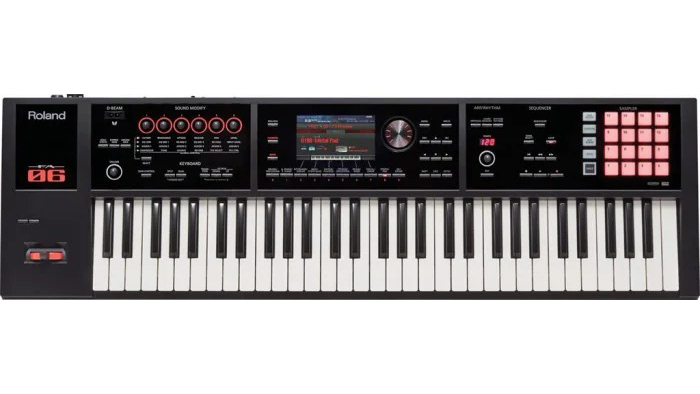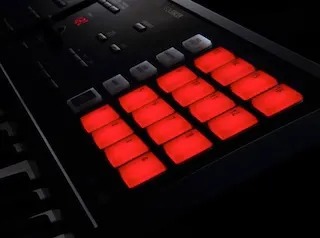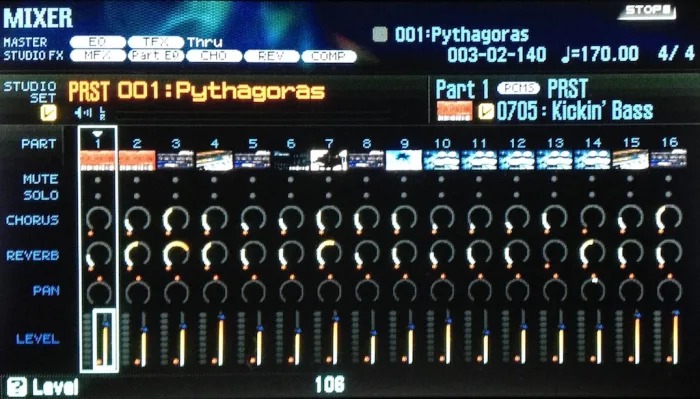Roland FA-06 review
We put the smaller FA synth to the test

Since the idea of the all-in-one synth/production workstation came into its own decades ago, Roland has cranked out all sorts of formidable, great sounding instruments used for composition, recording and performance by musicians in just about every genre.
The Fantom series has been around in a few different incarnations for quite a few years now, and has become a staple in many project and professional studios as well as being an integral part of countless live rigs. Their new FA series is a departure from older Fantom designs, yet the “FA” part of the name alludes that at least some of the lineage has been preserved. That new technological and sonic goodness can be found in Roland’s latest workstation offering? Let’s take it for a drive.
- The best MIDI keyboards for beginner and pro musicians
- Best synthesizers: keyboards, module and semi-modular synths
- Best pianos: acoustic and digital pianos for beginners and pros
- Best acoustic pianos: budget to premium instruments for home and studio
Panel tour
At 12.6 pounds, our FA-06 review unit is maybe the lightest full-function workstation we’ve come across. Its keyboard is an unweighted 61-key synth action with velocity sensitivity, but (like many other more affordable keyboards these days) no aftertouch. The action is surprisingly solid and responsive, but may not be the best choice if you’re planning on playing a lot of piano. If you’re in that category, Roland does makes a weighted 88-key version, the FA-08. Editor Stephen Fortner spent some time with the FA-08 at NAMM and said of its action, “It’s fast for a weighted keyboard, and feels like it would be non-fatiguing on a four-set gig where both piano and organ/synth type playing is required.”
On the surface, the FA’s interface appears more spartan than most of Roland’s previous workstations, but don’t be fooled—there’s a ton of power under the hood if you really dig in. Access to deeper editing functions can be achieved by holding down the Shift key and pushing another button, including the soft keys under the display to navigate the menus, many of which sport very cool and informative graphics. The main program section sports a large colour LCD, which is navigated using parent/peer buttons to its right side, with values changed using a large edit dial or increment/decrement buttons. There are ten category selection buttons under the display, six of which (2–7) do dual duty as soft keys in many of the editing modes. While using all the buttons to navigate the display isn’t complicated, it sometimes can take more than a few button presses to get around, and the FA would certainly be a lot easier to navigate if it had a touchscreen but that, of course, would increase the price.
To the left of the display, six Sound Modify knobs handle four rows of commonly tweaked settings via a Select button that changes their assignment (more below), and an additional row of Keyboard Mode buttons cover transposition, octave shift, and quick split and dual modes. Plus the Split and Dual buttons simultaneously, and you activate what Roland calls a Studio Set, wherein any combination of the 16 available parts that are set to the same channel can be played simultaneously from the keys. The DAW Control button allows the FA’s to act as a control surface for Logic Pro, Sonar, and Cubase), which in conjunction with its USB Audio/MIDI interface capabilities, could make it suitable as the nerve centre of your studio. Roland’s D-Beam is also on board, with individual buttons that toggle it between dedicated volume control, a handful of assignable parameters, and a fun Solo Synth mode that generates noise bursts reminiscent of Keith Emerson roaming the stage with his ribbon controller.
On the other side of the display, another small array of buttons engage the arpeggio and chord memory (which can be used at the same time), and select the rhythm pattern control screen, with a small numeric display that indicates the current arpeggio/rhythm tempo, kudos to Roland for providing both a dedicated tempo knob and a tap tempo button here. The remainder of the right side is taken up by the sequencer transport controls, and the backlit pads that provide access to the phrase sampler as well as being able to handle other tasks such as muting and soloing sequencer tracks and doing numeric keypad-like data entry.
404: found

The right side of the FA-06 and FA-08 is populated with what’s essentially a Roland SP-404SX phrase sampler. Four banks of 16 sounds each are available for instant playback, with no load time. You can roll your own samples using the onboard sounds or external audio inputs, or import AIFF, WAV, or MP3 files from your computer. Mono or stereo, one-shot or tightly looped, full-featured high-resolution sample editing is easy on the big display. The downside? The pads aren’t velocity-sensitive, so while they’re suitable for triggering loops and samples, they’re less so for playing in your own drum grooves.
Get the MusicRadar Newsletter
Want all the hottest music and gear news, reviews, deals, features and more, direct to your inbox? Sign up here.
Sound engine
Under the hood is a 128-note polyphonic synth engine with full 16-channel multitimbral capability. The onboard sound library is culled directly from Roland’s flagship Integra-7 module and made up of the complete sound set of the XV-5080, all of the “SuperNatural” synth sounds, and a carefully chosen assortment of the SuperNatural acoustic and drum sounds, all organised into over 2,000 Tones (Roland’s term for a single-sound patch). A Preview button lets you hear a phrase played with each Tone that indicates the way the programmer intended the sound to be used. This can be really interesting to check out, especially after you’ve explored a sound on your own for a while.
PCM-based programs can use up to four partials, and SuperNatural synth sounds allow up to three oscillators per voice. Single-cycle waveforms feature a couple of different variations, and the sawtooth wave has Roland’s signature “Super Saw” detune option on tap. A choice of two filters, two-pole (12dB per octave) and four-pole (24dB per octave) are available, each with multiple lowpass, highpass, and bandpass options. ADSR envelopes for the Filter and Amp sections (Pitch has a simple attack-decay envelope) and two LFOs round out the modulators.
The Tones are broken down into 20 categories, which can be accessed using the row of ten buttons under the display. Each of these house two categories (e.g., “A. Piano” and “E. Piano” share a button, as do Bass and Synth bass, Strings and Orchestra, Synth and Pad, and so on), and the first category is the default when the button is pushed. Organ sounds include “SuperNatural” patches with individual drawbar control (via the screen and/or Sound Modify knobs) and a very respectable Leslie simulation, after the fashion of Roland’s VK and VR series keyboards.
As previously mentioned, the FA-06 organises its Tones into Studio Sets, which can be comprised of up to 16 parts made up of onboard Tones or external sounds. These can be split and layered across the keys in any combination, and each of the 16 parts can be set to any MIDI channel, so it’s possible to play as many as you want at one time. The FA-06 does support Favourites: Ten banks of ten Favourite sounds each can be stored for easy recall using the Category buttons. Tones, Splits, Duals or entire Studio Sets can be saved as Favourites.
Sound modifiers and effects
These six knobs can do all sorts of things, depending on the setting of the Select button, which toggles them between four different rows. The first row sets the knobs to control Cutoff, Resonance, Attack (amp), Release (amp), Pan, and Level for each sound. The second sets each knob to cut or boost different EQ bands. The third row is assignable. The fourth row is all about effects. The first knob adds compression, the second knob modifies the overall EQ curve of the instrument, turning left boosts the mids (better for playing in a band) while turning it right boosts the lows and highs (more desirable in solo applications). Knobs 3 and 4 handle system chorus and reverb amounts. Knob 5 selects which Total Effect (TFX) is used, while knob 5 controls a preset parameter of the current TFX.
Speaking of effects, each of the parts in a Studio set can have it’s own multi-effect (MFX), chosen from a list of 67 effects (44 individual and 23 combinations such as Overdrive into Chorus or Distortion into Delay). Vocoder functionality is also available if a mic is plugged into the rear panel. Six Comp+EQ effects are onboard for levelling and tweaking drum sounds to taste. In addition, there are global Chorus and Reverb effects, a Master EQ and total effects (TFX), which include things like DJFX and BPM Loopers, Bit Crush, Slicer, Vinyl Sim and Radio Tuning, and process the entire signal (including all other effects). There’s even a dedicated input reverb that can be used while routing an external signal through the FA-06 when tracking or performing.
Sequencer
Looking at the front panel, it doesn’t appear that the sequencer is terribly flexible . . . but in fact, it’s very much so. The onboard 16-track sequencer offers real-time non-stop looping (with the ability to switch tracks while recording), linear and step-time recording options, track selection via the sampler pads, and full-featured editing—right down to the ability to see events graphically or in an edit list (called Microscope). A mixer page provides convenient access to pan, volume, reverb and chorus send, as well as mute and solo functions. The killer app here, though, is that sequences can be rendered to an inserted SD memory card not just as stereo mixes or Standard MIDI data (though these options are available, as is the case on many workstations and arranger keyboards), but as full-bandwidth individual tracks in WAV format. This lets you bang out sketches or cues using the FA’s keyboard, knobs, and sampler pads, and then bring all the tracks into your DAW for multitrack mixing and processing, without having to re-record audio or find appropriate soft synths for MIDI tracks to drive.

In use
While my deep inner synth geek does enjoy poking around under the hood, most of the time I get with keyboard instruments is spent playing them. I think that’s the heart and soul of what makes an instrument great—whether the sounds in it excite, intrigue, and stimulate. A nice keybed feel and an intuitive interface layout are helpful, of course, but if the sounds are there, most keyboard players will overlook just about any other shortcoming. In that respect, the FA-06 truly does shine, so much so that it’s hard to call out standout programs without churning out a really long list. It’s an exceptional sounding instrument in just about every category, and many of the sounds really do get extra life from the largely velocity-induced nuances of the SuperNatural programming.
Extra kudos are extended for essentially always being in Studio Set mode. It’s a lot of fun to be able to play some of the giant stacked and textured sounds, many of which may not be ideal for a particular track, but provide inspiration and a clear path to modifying a Studio Set to taste easily. The fact that Roland only made 64 presets and left 512 blank slots for Studio Sets is a good indicator that’s what they intended.
Once it becomes clear that holding the Shift button is the key to unlocking pretty much any section of the FA, it becomes a breeze to move around, with sharp graphics and sub-menus that show up in conjunction with the soft buttons indicating a very well laid out and logical workflow. It should also be pointed out that—unlike some other currently available workstations—realtime edits such as tweaking the cutoff and resonance knobs do not produce any audible stair-stepping effects.
The instrument does support “patch remain” (being able to change to another program while sustaining the previous sound without notes cutting off), but only under certain circumstances. You can change from program to program without having the previous program cut off in Single mode, but if the effects change from one program to another,you hear an audible burp—and more often than not, the effects do change. This, however, can be avoided in Sequencer or Studio Set mode. In either case, you can scroll up or back to a different part seamlessly. Even the sustain pedal can be used, sustaining the held sound and not affecting the new sound at all until the previous sound is released. “Patch remain” is not supported when switching Studio Sets, though—the previous sound is cut off entirely.
FA Connectivity
The rear panel houses the SDHC card slot, which comes pre-loaded with a 4GB card and can be used to export sequencer tracks as audio (more on this later). A pair of balanced 1/4" outputs are supplemented by a third balanced out (marked Sub Out), which can be used to send a click track or individual part that you don’t want in the main mix outs. The Sub Out is unaffected by the main volume slider. An 1/8" input allows monitoring of a stereo playback device, and an unbalanced 1/4" in can route a guitar, bass, or mic through the FA for monitoring, sampling, or direct routing to a DAW via USB. A dedicated Hold jack is provided for a sustain pedal, and two other jacks can be configured to operate with either a switch or a continuous pedal. A USB2 port allows direct connection to a computer, while a second USB port is available for hooking up a thumb drive for updating the instrument’s operating system or adding a WiFi dongle for enabling iPad control.
Verdict
While more and more keyboard players are doing the bulk of their recording and mixing on their computers or iOS devices, the need to be able to quickly grab and arrange an idea the moment inspiration hits means that there will always be a place on the market for synth workstations. The FA series takes the best of a bunch of Roland’s engines and libraries, rolls them together with a new ergonomic interface, and wraps it up in a solidly built, attractive package that’s even easy to transport. If you’re mainly recording using a DAW, it can even become an integral part of that workflow with the touch of a button. The FA is clearly one of Roland’s finest workstations to date, and is worth serious consideration by anyone looking to pick up a state-of-the-art all-in-one instrument.
Pros: Excellent sounds in every category. Informative, easy-to-read display with bright, crisp graphics. User interface is not intimidating for novices. Compatible with Roland Axial library. Included 4GB SD card. Deep onboard sequencer can render multitrack audio stems for further work in your DAW.
Cons: Display is not a touchscreen. Sampler pads aren’t velocity sensitive. Keys don’t sense aftertouch. External power supply.
Bottom line: A ton of power and sonic flexibility packed into an affordable, easy to operate, lightweight instrument.
FA-06: $1,399 list | $1,199 street
FA-08: $2,099 list | $1,899 street









